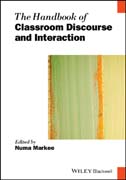
Offering an interdisciplinary approach, The Handbook ofClassroom Discourse and Interaction presents a series ofcontributions written by educators and applied linguists thatexplores the latest research methodologies and theories related toclassroom language. Organized to facilitate a critical understanding ofhow and why various research traditions differ and how they overlaptheoretically and methodologically Discusses key issues in the future development ofresearch in critical areas of education and applied linguistics Provides empirically–based analysis of classroomtalk to illustrate theoretical claims and methodologies Includes multimodal transcripts, an emerging trendin education and applied linguistics, particularly in conversationanalysis and sociocultural theory INDICE: Table of contents.1. Preliminary matters.1. Introduction: Classroom discourse and interactionresearch (Numa Markee). .2. Research Methodologies and Assessment.Overview.2. Developing A Multi–faceted Research Process: An EthnographicPerspective for Reading Across Traditions (Judith Green, MariaLúcia Castanheira, Audra Skukauskaite, and John Hammond).3. Understanding classroom discourse and interaction:Qualitative Perspectives. (Audra Skukauskaite, Denise Ramon,Jessica Rangel and Lisa Rodriguez)..4. Experimental perspectives on classroom interaction (MikeLong).5. Shifting trends in the assessment of classroom interaction(Marta Antón). .3. The Educational Tradition.Overview.6. Discourse and Learning in Contexts of Educational Interaction(Carl Fredericksen and Janet Donin).7. Can Neo–Marxist and post–structural theories in educationinform each other? Using genre approaches to bridge thegap (Ross Collin and Michael Apple).8. The role of talk in group based activity in languageclassrooms (David Bloome).9. The sequential analysis of instruction (Oskar Lindwall,Christian Greifenhagen and Gustav Lymer). .4. The Cognitive–Interactionist Tradition.Overview.10. The role of tasks as vehicles for learning in classroominteraction (YouJin Kim).11. Comprehensible input and output in classroom interaction(Sue Gass).12. An interactionist approach to learner–learner interaction insecond and foreign language classrooms (Melissa Bowles and RebeccaAdams).13. The relative effectiveness of corrective feedback inclassroom interaction (Roy Lyster).5. The Sociocultural Theory Tradition.Overview.14. From inter–action to intra–action: the internalization oftalk, gesture, and concepts in the second language classroom(Eduardo Negueruela–Azarola, Próspero García and KimberlyBuescher).15. Classroom Discourse and Interaction in the zone of proximaldevelopment (Holbrook Mahn).16. The emergence of sociolinguistic competence in secondlanguage classroom interaction (Rémi Van Compernolle).17. Expert–novice relationships in second language classroominteraction (Steve Thorne and John Hellerman). .6. The Language Socialization Tradition.Overview.18. The role of language socialization in heritage languageclassroom interaction (Agnes He).19. Language socialization across learning spaces (Jin Sook Leeand Mary Bucholtz)..20. Language and literacy socialization for immigrant andinternational students in educational contexts (Patricia Duff andTim Anderson).21. A language socialization perspective on identity work of ESLyouth in a superdiverse high school classroom (StevenTalmy). .7. The Conversation Analysis Tradition.Overview.22. L2 classroom interaction as a complex adaptive system (PaulSeedhouse).23. Institutional talk–for–learning beyond the classroom(Gabriele Kasper and Younhee Kim).24. Documenting change across time: longitudinal andcross–sectional CA studies of classroom interaction (SimonaPekarek–Doehler and Virginie Fasel Lauzon).25. CA–for–SLA studies of classroom interaction: Quo vadis?(Numa Markee and Silvia Kunitz). .8. The Critical Theory Tradition.Overview.26. Multilingual classroom discourse as a window on widersocial, political and ideological processes: Critical ethnographicapproaches (Marilyn Martin–Jones).27. Power, resistance and second language learning (ElizabethMiller).28. Seeing language and development play out inclassroom interaction (Roslyn Appleby).29. The social construction of inequality in and throughinteraction in bilingual classrooms (Luisa Martín Rojo). .9. Final Words.30. Where does research on classroom discourse and interactiongo from here? (Numa Markee).Appendix.Transcription conventions.Author index.Subject index
- ISBN: 978-1-118-53112-9
- Editorial: Wiley Blackwell
- Encuadernacion: Rústica
- Páginas: 576
- Fecha Publicación: 21/04/2015
- Nº Volúmenes: 1
- Idioma: Inglés
